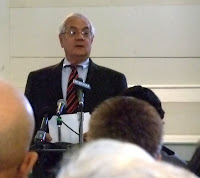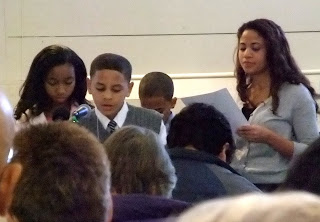I got to New Bedford early and took advantage of the balmy (for February) weather to roam the neighborhood. First stop: the Lewis Temple statue in front of the Public Library. Temple was a blacksmith, and inventor, who moved to New Bedford in the 1820s. Clifford Ashley in The Yankee Whaler notes that, with the opening of the Kodiak whaling grounds in 1835, whalemen observed the walrus and seal spears of the indigenous hunters. Their detachable spear-head was seen as being more effective than the flexible, single-flued iron then prevalent in whaling. "Over one hundred harpoon patent applications were filed in Washington within the next few years." In 1848, Lewis Temple came up with a design that "was of such extremely simple construction, and at the same time was so practical, that it was at once adopted to the exclusion of all others." Ashley continues...
With but one small change , to permit easier manufacture, it has continued to be the standard harpoon of the fishery. ... It is safe to say that the Temple toggle was the most important single invention in the whole history of whaling, since it resulted in the capture of a far greater proportion of the whales that were struck than had before been possible.Temple's design was never patented. Upon his death, the statue's plaque informs us, "after business debts were cleared, there was no legacy left for his family."
On the next block is the Frederick Douglass Monument. From the website of the New Bedford Historical Society:
This monument is dedicated to Frederick Douglass and his wife Anna who escaped slavery by the underground railroad and made New Bedford their home for five years 1838-1843. Two of their children were born here, Rosetta (1839) and Lewis (1840). Dedicated on October 17, 1996, this monument commemorates the 100th anniversary of his death in 1895. Sponsored by the City of New Bedford and the New Bedford Chapter of the NAACP.
 |
| Friends Meeting House |
Each reader was assigned a specific passage. Dr. Robertson-Lorant distributed the texts — five or six pages printed in a comfortably large font, stapled together. All attendees were given a Dover edition of Douglass's work, to follow along. A generous spread of food and drink was available in the adjoining hall.
 |
| Marlena Johnson |
 |
| Rep. Barney Frank |
 |
| Mayor Jon Mitchell |
 |
| Rep. Wm. Keating |
Ms. Johnson opened the event with a superb rendition of "Lift Every Voice." There followed a presentation to U.S. Representative Barney Frank, and a few introductions and announcements. Dr. Mary Louise Francis, Superintendent of Schools, was warmly applauded for her declaration that the Douglass autobiography will be "mandatory reading for New Bedford public schools."
Then we were off. Mr. Frank read first, followed by New Bedford mayor Jonathan Mitchell, and U.S. Representative William Keating.
A few familiar faces from MDM16 were among the readers -- Jen Nersesian (in her Nat'l Historical Park uniform), Scott Lang, Jim Lopes, and Michael Dyer.
Most impressive were the youngest readers, from local grammar and middle schools. I'd say that the future is in good hands.
Scanning the audience, I was reminded of the ethnically diverse New Bedford of Chapter 6 in M-D. We were a mix of cultures, of backgrounds, of ages; husbands and wives, parents and children. While the text described extreme cruelties, we pondered it together, and together marveled at one man's strength and intelligence. Was I the only one who felt a tacit, mutual pledge to look for the best in each other?






Thank you, Gansevoort, for the Frederick Douglass Marathon post - it brought a tear to my eye. I recently read Gone with the Wind, Uncle Tom's Cabin, and Douglass' life's narrative - I'd never read any of them in school. Douglass' narrative and Uncle Tom's Cabin were no shock to me but I WAS struck by Mitchell's portrayal of and seeming attitude towards slavery. Slaves are treated as part of the family, etc. I wonder just how many slaves felt the slightest bit as if they were a part of any family? How easy and yet how dangerous it is to romanticize the past.
ReplyDelete